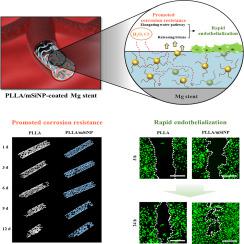Biomaterials Advances ( IF 5.5 ) Pub Date : 2021-06-07 , DOI: 10.1016/j.msec.2021.112239 Suhyung Park 1 , Hyun Lee 2 , Hyoun-Ee Kim 3 , Hyun-Do Jung 2 , Tae-Sik Jang 4

|
Biodegradable magnesium (Mg)-based vascular stents can overcome the limitations of conventional permanent metallic stents, such as late in-stent restenosis and thrombosis, but still have difficulty retarding degradation while providing adequate mechanical support to the blood vessel. We incorporated silica nanoparticles surface-functionalized with hexadecyltrimethoxysilane (mSiNP) into a poly (l-lactic acid) (PLLA) coating as a physical barrier to disturb the penetration of the corrosive medium as well as a bioactive source that releases silicon ions capable of stimulating endothelial cells. The corrosion resistance and biocompatibility of this bifunctional PLLA/mSiNP nanocomposite coating were investigated using different weight ratios of mSiNP. The nanocomposite coating containing more than 10 wt% of the mSiNP (PLLA/10mSiNP and PLLA/20mSiNP) significantly delayed the corrosion of the Mg substrate and exhibited favorable endothelial cell responses, compared to the pure PLLA coating. Specifically, the calculated corrosion rates of PLLA/10mSiNP and PLLA/20mSiNP decreased by half, indicating the durability of the coating after immersion in simulated body fluid for 12 days. Based on the in vitro cellular response, the incorporation of the mSiNPs into the PLLA coating significantly improved the endothelial cell responses to the Mg substrate, showing better initial cell surface coverage, migration, and proliferation rate than those of pure PLLA. These results indicate that the PLLA/mSiNP nanocomposite coatings have significant potential to improve the corrosion resistance and vascular compatibility of biodegradable Mg-based vascular stents.
中文翻译:

双功能聚(l-乳酸)/疏水二氧化硅纳米复合层涂覆在镁支架上以增强耐腐蚀性和内皮细胞反应
可生物降解的镁 (Mg) 血管支架可以克服传统永久性金属支架的局限性,如支架内晚期再狭窄和血栓形成,但在为血管提供足够机械支撑的同时仍难以阻止降解。我们将用十六烷基三甲氧基硅烷 (mSiNP) 表面功能化的二氧化硅纳米粒子结合到聚 ( l-乳酸)(PLLA)涂层作为物理屏障来干扰腐蚀性介质的渗透以及释放能够刺激内皮细胞的硅离子的生物活性源。使用不同重量比的 mSiNP 研究了这种双功能 PLLA/mSiNP 纳米复合涂层的耐腐蚀性和生物相容性。与纯 PLLA 涂层相比,含有超过 10 wt% mSiNP(PLLA/10mSiNP 和 PLLA/20mSiNP)的纳米复合涂层显着延迟了镁基体的腐蚀并表现出良好的内皮细胞响应。具体而言,计算出的 PLLA/10mSiNP 和 PLLA/20mSiNP 的腐蚀速率降低了一半,表明涂层在模拟体液中浸泡 12 天后具有耐久性。基于体外细胞反应,将 mSiNPs 掺入 PLLA 涂层显着改善了内皮细胞对镁基质的反应,显示出比纯 PLLA 更好的初始细胞表面覆盖、迁移和增殖率。这些结果表明,PLLA/mSiNP 纳米复合涂层在提高可生物降解镁基血管支架的耐腐蚀性和血管相容性方面具有显着的潜力。











































 京公网安备 11010802027423号
京公网安备 11010802027423号